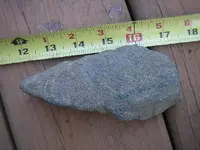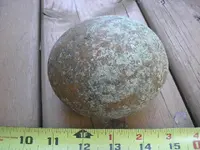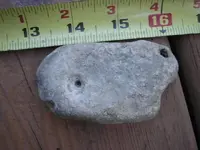As some of you remember I have posted some pics that have not been rec'd well. No problem. I am relatively new to artifact collecting, and my 'stuff' does not quite match up to the typical reference pics. I have classified things wrong, have been corrected without taking offense, (Thank You), and have made some newbie mistakes. But I still have some questions.
As I have explained before, I live in extreme NE Ohio. This area has had some unique NA (ancient) history. For a long time this area was a hunting ground only. They are still debating which ppls have lived here over the milleniums. They have flip flopped between Erie and Missasauga to name two. They also have named a group called the Whittesley ppl after a 19th century Military man who explored Ohio mounds and areas of interest.
This area also had some habitation by ppls who are closely associated to NY NA's. I am reading 'The Archaeology of NY State' by Ritchie for reference. These ppls had no pottery, no grooved axes, were hunter/gather's only, and some looked different from the typical NA build and stature. Some were called the 'Long Head's'. Some were 'Round Heads'. They practiced cannibalism. I'm not sure how unique that is, IIRC, the Iroqouis did that also. I'm not even sure if that's relevant. But I mention that to further explain some of these ppls. They were buried with scant articles. Some of their tools also looked different. The Beveled Adze is the diagnostic tool for one of these cultures. Found associated with no other ppls. A Gouge is associated with one culture, but not the previous ppls to occupy the area. I mention these to illustrate some differences between what is found in different parts of the country.
Questions I have are--
1. Does anyone have a reference to someone who specializes in NY-type cultures? Creekside Artifacts is no longer in business. I would imagine someone associated with ASO would be familiar with these types. I thot maybe someone who has been a long time member may have a good contact. Thanks
2. Since at least one of the NY cultures had no grooved tools, Does it make sense that there tools would look different and be hand held? This is a serious question as I have wondered about the evolution of tool forms from older to newer. I would think that a Grooved Ax followed another form of chopping tool . Much like any other tool, or object, has been refined and bettered after observation and use. A Beveled Adze or Plano-Convex Adze looks significantly different than other adze's that are posted from other parts of the country. I realize this is possibly a hypothetical question but it has bothered me re: my observations.
3. At least one of these ppls made dug out canoes. Chopping, digging and scooping tools would be needed. Does anyone have known examples of woodworking tools that were not hafted, (from earlier time periods), and look different? Would it be what many call a Chopper, Adze, Celt?
4. Ritchie has a short blurb re: crude effigies on artifacts found at one site. I would imagine most Archaeologists would be hesitant to report 'faces and symbols' found on artifacts. In all serious forums or discussions it is the 'kiss of death' to report seeing faces or symbols, other than crude stickman figures. Has anyone found an artifact that looks like it has man-made faces or symbols on it? Just curious..
5. What is the artifact called that would be like a hand held nutting stone, or is mortar-like but meant to be to be hand held. Most have smooth indents or areas, not necessarily rough pitted. An anvil, or is there a specific term? Thanks
6. I know mounds are usually taller and round. Have any been found that are laid parrell to each other, 3-4' wide, are in rows and not tall. Not saying I know where mounds are, but wonder what different shapes they are.
I want to iterate that I am not mocking anyone, (heck, I may have been the one someone was mocking). But I have some questions that I can not answer. I am looking for a contact for someone versed in artifacts that more closely resemble NY artifacts than ones from Ohio. University, Archaeologist, Historical Society, Collector, etc.
I also want to point out that I am new to collecting and make frequent mistakes. I also can get sidetracked with speculation. I am however, more than willing to admit my mistakes, and take constructive criticism, so that I may learn. Some of you are very learned in your areas of expertise. I appreciate your input. TIA
As I have explained before, I live in extreme NE Ohio. This area has had some unique NA (ancient) history. For a long time this area was a hunting ground only. They are still debating which ppls have lived here over the milleniums. They have flip flopped between Erie and Missasauga to name two. They also have named a group called the Whittesley ppl after a 19th century Military man who explored Ohio mounds and areas of interest.
This area also had some habitation by ppls who are closely associated to NY NA's. I am reading 'The Archaeology of NY State' by Ritchie for reference. These ppls had no pottery, no grooved axes, were hunter/gather's only, and some looked different from the typical NA build and stature. Some were called the 'Long Head's'. Some were 'Round Heads'. They practiced cannibalism. I'm not sure how unique that is, IIRC, the Iroqouis did that also. I'm not even sure if that's relevant. But I mention that to further explain some of these ppls. They were buried with scant articles. Some of their tools also looked different. The Beveled Adze is the diagnostic tool for one of these cultures. Found associated with no other ppls. A Gouge is associated with one culture, but not the previous ppls to occupy the area. I mention these to illustrate some differences between what is found in different parts of the country.
Questions I have are--
1. Does anyone have a reference to someone who specializes in NY-type cultures? Creekside Artifacts is no longer in business. I would imagine someone associated with ASO would be familiar with these types. I thot maybe someone who has been a long time member may have a good contact. Thanks
2. Since at least one of the NY cultures had no grooved tools, Does it make sense that there tools would look different and be hand held? This is a serious question as I have wondered about the evolution of tool forms from older to newer. I would think that a Grooved Ax followed another form of chopping tool . Much like any other tool, or object, has been refined and bettered after observation and use. A Beveled Adze or Plano-Convex Adze looks significantly different than other adze's that are posted from other parts of the country. I realize this is possibly a hypothetical question but it has bothered me re: my observations.
3. At least one of these ppls made dug out canoes. Chopping, digging and scooping tools would be needed. Does anyone have known examples of woodworking tools that were not hafted, (from earlier time periods), and look different? Would it be what many call a Chopper, Adze, Celt?
4. Ritchie has a short blurb re: crude effigies on artifacts found at one site. I would imagine most Archaeologists would be hesitant to report 'faces and symbols' found on artifacts. In all serious forums or discussions it is the 'kiss of death' to report seeing faces or symbols, other than crude stickman figures. Has anyone found an artifact that looks like it has man-made faces or symbols on it? Just curious..
5. What is the artifact called that would be like a hand held nutting stone, or is mortar-like but meant to be to be hand held. Most have smooth indents or areas, not necessarily rough pitted. An anvil, or is there a specific term? Thanks
6. I know mounds are usually taller and round. Have any been found that are laid parrell to each other, 3-4' wide, are in rows and not tall. Not saying I know where mounds are, but wonder what different shapes they are.
I want to iterate that I am not mocking anyone, (heck, I may have been the one someone was mocking). But I have some questions that I can not answer. I am looking for a contact for someone versed in artifacts that more closely resemble NY artifacts than ones from Ohio. University, Archaeologist, Historical Society, Collector, etc.
I also want to point out that I am new to collecting and make frequent mistakes. I also can get sidetracked with speculation. I am however, more than willing to admit my mistakes, and take constructive criticism, so that I may learn. Some of you are very learned in your areas of expertise. I appreciate your input. TIA
Upvote
0




 .
.




